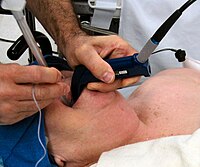
Photo from wikipedia
been published [1]. We agree that the use of supraglottic airway devices (SADs) as a conduit for awake tracheal intubation warrants future investigation. We recently reported a case series of… Click to show full abstract
been published [1]. We agree that the use of supraglottic airway devices (SADs) as a conduit for awake tracheal intubation warrants future investigation. We recently reported a case series of awake supraglottic airway-guided flexible bronchoscopic intubation (SAGFBI) [2], a technique that may offer additional advantages to conventional FBI. The technique allows three preliminary tests in the awake patient before proceeding with SAGFBI and the subsequent induction of anesthesia. 1. “Awake test insertion” of the SAD determines if it can be inserted into a patient with moderately restricted mouth opening. The oral route may be preferred for awake intubation because of issues with surgical access, the presence of nasal pathology, or an increased risk of epistaxis. In our case series [2], we successfully inserted an Ambu Auragain(Ambu A/S, Ballerup, Denmark) size 3 into patients with interdental distances of 16 and 20 mm despite the product specifications recommending a required distance of 21 mm for insertion. We warmed the SAD to soften it in order to facilitate its insertion. 2. The “awake look” (along with other awake intubation techniques) allows evaluation of the periglottic region to identify any anatomical distortion or local pathology that may cause difficulties with intubation or indicate that a different technique for securing the airway should be used, e.g., front-of-neck access. 3. “Awake test ventilation” confirms whether ventilation via SADs is possible or not in an awake patient. A normal square capnograph waveform indicates satisfactory SAD positioning, which makes obtaining a partial or full glottic view during SAGFBI more likely [2]. By ruling out the “cannot ventilate” scenario, it provides some reassurance before proceeding with the induction of anesthesia and administration of muscle relaxants. The latter should be avoided in cases of difficult airways since the preservation of spontaneous ventilation is indicated. Failed ventilation may result from SAD malposition or anatomical factors. Both are likely to cause failure of SAGFBI, and corrective SAD strategies [3] or a different technique to secure the airway, respectively, should be considered. Other aspects of awake SAGFBI may make it preferable to other awake intubation techniques, including patients’ tolerance for the SAD during insertion and SAD functionality. Awake SAD insertion may be more tolerable compared to awake direct or video laryngoscopy for three reasons. First, SAD cuffs are relatively soft, as they are made of silicone (LMA Classic [Intavent Orthofix Ltd., Maidenhead, United Kingdom]), polyvinyl chloride (LMA Supreme [LMA North America, Inc., USA]), or medical-grade thermoplastic elastomer (I-gel [Intersurgical Ltd, United Kingdom]), compared to a hard plastic or metal laryngoscope blade. Therefore, SAD insertion may cause less oropharynKorean J Anesthesiol 2020;73(4):352-353 https://doi.org/10.4097/kja.20174 pISSN 2005–6419 • eISSN 2005–7563
Journal Title: Korean Journal of Anesthesiology
Year Published: 2020
Link to full text (if available)
Share on Social Media: Sign Up to like & get
recommendations!